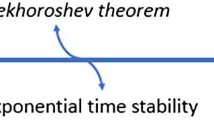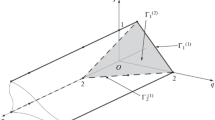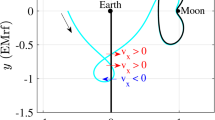Abstract
In the last decades, we have seen a rapid increment in the use of finite-time chaos indicators in celestial mechanics. They have been used to analyze the complex dynamics of planetary systems, of minor planets and of space debris. In fact, theoretical studies on fundamental dynamical models have revealed that, computed on short time intervals, they allow to efficiently detect resonances, represent the phase portraits of complex dynamics, compute center-stable-unstable manifolds as well as Lagrangian coherent structures. In this paper, we focus on applications of the fast Lyapunov indicator (FLI) and review through examples why its computation is particularly powerful for those systems whose solutions may have an asymptotic behavior very different from the short-term one, as it is the case of sequences of close encounters in gravitational systems and the advection of particles in aperiodic flows. The main case study here considered is the computation of the manifold tubes and the related transit orbits in the restricted three-body problem. We also provide a new application of the FLI to a complex problem of planetary hydrodynamics, such as the detection of the stable and unstable manifolds guiding the motions of particles advected by the gas of a protoplanetary nebula.






















Similar content being viewed by others
Data Availability
The code fargoOCA is available at: https://disc.pages.oca.eu/fargOCA/public/.
Notes
For the Sun–Jupiter mass ratio, we have \(C_1= 3.0387...\), \(C_2= 3.0374...\); for the numerical experiments we use \(C=3.0368...\). We remark that the values of the Jacobi constant \(C_1,C_2\) are very close, and in particular, small changes of C close to \(C_1,C_2\) determine important changes in the shape of the realm of possible motions.
A recently re-factorized version of the code can be found at: https://disc.pages.oca.eu/fargOCA/public/. The code is parallelized using a hybrid combination of MPI between the nodes and accelerated using the Kokkos library. This gives the possibility of running the code on a large variety of machine’s architectures mixing CPUs and GPUs.
References
Anderson, R.L., Easton, R.W., Lo, M.W.: Isolating blocks as computational tools in the circular restricted three-body problem. Phys. D 343, 38–50 (2017)
Alves, Silva R., Beaugé, C., Ferraz-Mello, S., Cincotta, P.M., Giordano, C.M.: Instability times in the HD 181433 exoplanetary system. Astron. Astrophys. 652, A112 (2021)
Baruteau, C., Masset, F.: On the corotation torque in a radiatively inefficient disk. Astrophys. J. 672, 1054 (2008)
Benettin, G., Galgani, L., Strelcyn, J.M.: Kolmogorov entropy and numerical experiments. Phys. Rev. A 14, 2338–2345 (1976)
Benettin, G., Galgani, L., Giorgilli, A., Strelcyn, J.M.: Tous les nombres caracteristiques de Lyapunov sont effectivement calculables. Comptes Rendus Acad. Sc. Paris 286A, 431 (1978)
Cardin, F., Guzzo, M.: Integrability of close encounters in the spatial restricted three-body problem. Commun. Contemp. Math. 24(06), 2150040 (2022)
Ceccaroni, M., Celletti, A., Pucacco, G.: Halo orbits around the collinear points of the restricted three-body problem. Phys. D 317(1), 28–42 (2016)
Celletti, A., Gales, C.: On the dynamics of space debris: 1:1 and 2:1 resonances. J. Nonlin. Sci 24, 1231C (2014)
Celletti, A., Gales, C.: Dynamical investigation of minor resonances for space debris. Celest. Mech. Dynam. Astron. 123, 203–222 (2015)
Celletti, A., Lega, E., Stefanelli, L., Froeschlé, C.: Some results on the global dynamics of the regularized restricted three-body problem with dissipation. Celest. Mech. Dyn. Astron. 109, 265–284 (2011)
Celletti, A., Pucacco, G., Stella, D.: Lissajous and Halo orbits in the restricted three-body problem. J. Nonlinear Sci. 25, 2 (2015)
Cincotta, P., Simó, C.: Simple tools to study global dynamics in non-axisymmetric galactic potentials-I. Astron. Astrophys. Suppl. Ser. 147, 205 (2000)
Cincotta, P.M., Giordano, C.M., Simó, C.: Phase space structure of multi-dimensional systems by means of the mean exponential growth factor of nearby orbits. Phys. D 182(3–4), 151–178 (2003)
Couturier, J., Robutel, P., Correia, A.C.M.: Dynamics of co-orbital exoplanets in a first-order resonance chain with tidal dissipation. Astron. Astrophys. 664, A1 (2022)
Conley, C.: Low energy transit orbits in the restricted three-body problems. SIAM J. Appl. Math. 16(4), 732–746 (1967)
Daquin, J., Legnaro, E., Gkolias, I., Efthymiopoulos, C.: A deep dive into the 2g+h resonance: separatrices, manifolds and phase space structure of navigation satellites. Cel. Mech. Dyn. Astron. 134, 6 (2022)
Delrez, L., Ehrenreich, D., Alibert, Y., Bonfanti, A., et al.: Transit detection of the long-period volatile-rich super-Earth \(\nu ^2\) Lupi d with CHEOPS. Nature Astron. 5, 775–787 (2021)
Froeschlé, C., Guzzo, M., Lega, E.: Graphical evolution of the Arnold web: from order to chaos. Science 289(5487), 2108–2110 (2000)
Froeschlé, C., Lega, E., Gonczi, R.: Fast Lyapunov indicators. Application to asteroidal motion. Celest. Mech. Dyn. Astron. 67, 41–62 (1997)
Fung, J., Artymowicz, P., Wu, Y.: The 3D flow field around an embedded planet. Astrophys. J. 811, 101 (2015)
Garth, C., Gerhardt, F., Tricoche, X., Hagen, H.: Efficient computation and visualization of coherent structures in fluid flow applications. IEEE Trans. Visual Comput. Graphics 13(6), 1464–1471 (2007)
Gkolias, I., Daquin, J., Skoulidou, D.K., Tsiganis, K., Efthymiopoulos, C.: Chaotic transport of navigation satellites. Chaos 29(10), 101106 (2019)
Gillon, M., et al.: Seven temperate terrestrial planets around the nearby ultracool dwarf star TRAPPIST-1. Nature 542, 23 (2017)
Gomez, G., Koon, W.S., Lo, M.W., Marsden, J.E., Masdemont, J., Ross, S.D.: Connecting orbits and invariant manifolds in the spatial restricted three-body problem. Nonlinearity 17, 1571–1606 (2004)
Gómez, G., Jorba, À., Masdemont, J., Simó, C.: Dynamics and Mission Design Near Libration Point Orbits, Vol. 3: Advanced Methods for Collinear Points, World Scientific, Singapore, (2000)
Guzzo, M.: The web of three-planet resonances in the outer solar system II. A source of orbital instability for uranus and neptune. Icarus 181, 475–485 (2006)
Guzzo, M., Lega, E.: On the identification of multiple close-encounters in the planar circular restricted three body problem. Mon. Not. R. Astron. Soc. 428, 2688–2694 (2013)
Guzzo, M., Lega, E.: Evolution of the tangent vectors and localization of the stable and unstable manifolds of hyperbolic orbits by fast Lyapunov indicators. SIAM J. Appl. Math. 74(4), 1058–1086 (2014)
Guzzo, M., Lega, E.: A study of the past dynamics of comet 67P/Churyumov-Gerasimenko with fast Lyapunov indicators. Astron. Astrophys. 579(A79), 1–7 (2015)
Guzzo, M., Lega, E.: Scenarios for the dynamics of comet 67P/Churyumov-Gerasimenko over the past 500 kyr. Mon. Not. R. Astron. Soc. 469, S321–S328 (2017)
Guzzo, M., Lega, E.: Geometric chaos indicators and computations of the spherical hypertube manifolds of the spatial circular restricted three-body problem. Phys. D 373, 38–58 (2018)
Haller, G.: Distinguished material surfaces and coherent structures in three-dimensional fluid flows. Phys. D 149, 248–277 (2000)
Haller, G.: Lagrangian coherent structures from approximate velocity data. Phys. Fluids 14(6), 1851–1861 (2002)
Haller, G.: Lagrangian coherent structures. Annu. Rev. Fluid Mech. 47, 137–162 (2015)
Hoang, Nam H., Mogavero, F., Laskar, J.: Chaotic diffusion of the fundamental frequencies in the solar system. Astron. Astrophys. 654, A156 (2021)
Jiménez, M.A., Masset, F.S.: Improved torque formula for low-and intermediate-mass planetary migration. Mon. Not. R. Astron. Soc. 471, 4917 (2017)
Jorba, A., Masdemont, J.: Dynamics in the center manifold of the restricted three-body problem. Phys. D 132, 189–213 (1999)
Kley, W., Nelson, R.P.: Planet-disk interaction and orbital evolution. Ann. Rev. Astron. Astrophys. 50, 211–249 (2012)
Kley, W., Bitsch, B., Klahr, H.: Planet migration in three-dimensional radiative discs. Astron. Astrophys. 506, 971 (2009)
Koon, W.S., Lo, M.W., Marsden, J.E., Ross, S.D.: Dynamical systems, the three body problem and space mission design. Marsden Books. ISBN 978-0-615-24095-4, (2008)
Kustaanheimo, P.: Spinor regularisation of the Kepler motion, Annales Universitatis Turkuensis A 73, 1-7. Also Publications of the Astronomical Observatory Helsinki 102, (1964)
Kustaanheimo, P., Stiefel, E.L.: Perturbation theory of Kepler motion based on spinor regularization. J. Reine Angew. Math. 218, 204–219 (1965)
Izidoro, A., Bitsch, B., Raymond, S.N., et al.: Formation of planetary systems by pebble accretion and migration. Hot super-Earth systems from breaking compact resonant chains. Astron. Astrophys. 650, A152 (2021)
Lambrechts, M., Lega, E.: Reduced gas accretion on super-Earths and ice giants. Astron. Astrophys. 606, A146 (2017)
Laskar, J.: The chaotic motion of the solar system. A numerical estimate of the size of the chaotic zones. Icarus 88, 266–291 (1990)
Laskar, J., Froeschlé, C.L., Celletti, A.: The measure of chaos by the numerical analysis of the fundamental frequencies. Application to the standard mapping. Phys. D 56(2–3), 253–269 (1992)
Laskar, J.: Frequency analysis for multi-dimensional systems. Global dynamics and diffusion. Phys. D 67, 257 (1993)
Lega, E., Guzzo, M., Froeschlé, C.: Detection of close encounters and resonances in three-body problems through Levi-Civita regularization. Mon. Not. R. Astron. Soc. 418, 107–113 (2011)
Lega, E., Crida, A., Bitsch, B., Morbidelli, A.: Migration of Earth-sized planets in 3D radiative discs. Mon. Not. R. Astron. Soc. 440, 683–695 (2014)
Lega, E., Guzzo, M.: Three-dimensional representations of the tube manifolds of the planar restricted three-body problem. Phys. D 325, 41–52 (2016a)
Lega, E., Guzzo, M.: Theory and applications of the fast Lyapunov indicator (FLI) Method, In: Lecture Notes in Physics 915, Chaos Detection and Predictability, pp. 35-54, (2016b)
Lekien, F., Shadden, S.C., Marsden, J.E.: Lagrangian coherent structures in n-dimensional systems. J. Math. Phys. 48, 065404 (2007)
Lemaitre, A., Delsate, N., Valk, S.: A web of secondary resonances for large A/m geostationary debris. Celest. Mech. Dyn. Astron. 104, 383 (2009)
Levi-Civita, T.: Sur la régularisation qualitative du probléme restreint des trois corps. Acta Math. 30, 305–327 (1906)
Lipinski, D., Mohseni, K.: A 3D fast algorithm for computing Lagrangian coherent structures via ridge tracking, arXiv:1202.5236v1, (2012)
Martí, J.G., Cincotta, P.M., Beaugé, C.: Chaotic diffusion in the Gliese-876 planetary system. Mon. Not. R. Astron. Soc. 460(1), 1094–1105 (2016)
Masdemont, J.J.: High order expansions of invariant manifolds of libration point orbits with applications to mission design. Dyn. Syst. Int. J. 20(1), 59–113 (2005)
Mezić, I., Wiggins, S.: A method for visualization of invariant sets of dynamical systems based on the ergodic partition. Chaos 9, 213–218 (1999)
Mitchenko, T.A., Ferraz-Mello, S.: Resonant structure of the outer solar system in the neighborhood of the planets. Astron. J. 122, 474–481 (2001)
Oseledets, I.: A multiplicative ergodic theorem: Lyapunov characteristic numbers for dynamical systems. Trans. Moscow Math. Soc. 19, 197–231 (1968)
Paez, R.I., Guzzo, M.: A study of temporary captures and collisions in the circular restricted three-body problem with normalizations of the Levi-Civita hamiltonian. Int. J. Non-Lin. Mech. 120, 103417 (2020)
Paardekooper, S.-J., Baruteau, C., Crida, A., Kley, W.: A torque formula for non-isothermal type I planetary migration. Mon. Not. R. Astron. Soc. 401, 1950 (2010)
Pucacco, G.: Structure of the centre manifold of the \(L_1,L_2\) collinear libration points in the restricted three-body problem, Cel. Mech. Dyn. Astr., 131(44), (2019)
Robutel, P., Laskar, J.: Frequency map and global dynamics in the solar system I. Icarus 52(1), 4–28 (2001)
Robutel, P.: Frequency map analysis and quasiperiodic decompositions, In: Hamiltonian Systems and Fourier Analysis, pp. 179–198. Camb. Sci. Publ., Cambridge (2005)
Robutel, P., Galern, F.: The resonant structure of Jupiter’s Trojan asteroids I. Long term stability and diffusion. Mon. Not. R. Astron. Soc. 372, 1463–1482 (2006)
Scantamburlo, E., Guzzo, M.: Short-period effects of the planetary perturbations on the Sun-Earth Lagrangian point L3. Astron. Astrophys. 638, A137 (2020)
Shadden, S.C., Lekien, F., Marsden, J.E.: Definition and properties of Lagrangian coherent structures from finite-time Lyapunov exponents in two-dimensional aperiodic flows. Phys. D 212, 271–304 (2005)
Simó, C.: Dynamical systems methods for space missions on a vicinity of collinear libration points, In: Simó, C., (ed.) Hamiltonian Systems with Three or More Degrees of Freedom (S’Agaró, 1995), volume 533 of NATO Adv. Sci. Inst. Ser. C Math. Phys. Sci., pp. 223-241, Dordrecht. Kluwer Acad. Publ., (1999)
Szebehely, V.: Theory of orbits. Academic Press, New York (1967)
Tang, X.Z., Boozer, A.H.: Finite time Lyapunov exponent and advection-diffusion equation. Phys. D 95, 283–305 (1996)
Todorović, N., Wu, D., Rosengren, A.J.: The arches of chaos in the solar system. Sci. Adv. 6(48), (2020)
Volpi, M., Roisin, A., Libert, A.-S.: The 3D secular dynamics of radial-velocity-detected planetary systems. Astron. Astrophys. 626, A74 (2019)
Wiggins, S.: The dynamical systems approach to Lagrangian transport in oceanic flows. Annu. Rev. Fluid Mech. 37, 295 (2005)
Zanzottera, A., Castelli, R., Mingotti, G., Dellnitz, M.: Intersecting invariant manifolds in spatial restricted three-body problems: design and optimization of Earth-to-halo transfers in the Sun-Earth-Moon scenario. Commun. Nonlinear Sci. Num. Sim. 17(2), 832–843 (2012)
Acknowledgements
We acknowledge HPC resources from GENCI DARI n.A0120407233 and from “Mesocentre SIGAMM” hosted by Observatoire de la Côte d’Azur. M.G. acknowledges the project MIUR-PRIN 20178CJA2B “New frontiers of Celestial Mechanics: theory and applications.”
Author information
Authors and Affiliations
Corresponding author
Ethics declarations
Conflict of interest.
The authors have no competing interests, or other interests that might be perceived to influence the results and/or discussion reported in this paper.
Additional information
Dedicated to the memory of Claude Froeschlé, we had the immense honor to embrace your intuition for disentangling intricate dynamics into beautiful and elegant images.
Publisher's Note
Springer Nature remains neutral with regard to jurisdictional claims in published maps and institutional affiliations.
Rights and permissions
Springer Nature or its licensor (e.g. a society or other partner) holds exclusive rights to this article under a publishing agreement with the author(s) or other rightsholder(s); author self-archiving of the accepted manuscript version of this article is solely governed by the terms of such publishing agreement and applicable law.
About this article
Cite this article
Guzzo, M., Lega, E. Theory and applications of fast Lyapunov indicators to model problems of celestial mechanics. Celest Mech Dyn Astron 135, 37 (2023). https://doi.org/10.1007/s10569-023-10152-5
Received:
Revised:
Accepted:
Published:
DOI: https://doi.org/10.1007/s10569-023-10152-5




